Food for thought: Sustainable practices in ISU Dining locations
ISU Dining has gone away from using trays to carry food and instead has changed conveyer belts to transport the dirty dishes.
January 25, 2017
At lunch in the Union Drive Marketplace, you scrape your fork against the last few chunks of food on your plate you’re too full to eat and decide you are done.
Getting up, you grab your coat and walk to the dish conveyor belt at the back of the dining area, habitually placing your plate and leftover food scraps on the belt and allowing your discarded food to disappear slowly into the wall.
What many customers at ISU Dining locations don’t think about after they’ve discarded their waste is what happens to their scraps. What may interest some is that ISU Dining locations not only have thoughtful processes in place to handle their daily waste — they are using methods that improve their efficiency and reduce the environmental impact.
“Not a whole lot of people know about how sustainable we are,” Brittney Rutherford, marketing coordinator of ISU Dining and Residence, said.
While some may have seen posters that they can purchase a reusable dinner container for these locations or that they can save $0.35 at any dining location when they bring their own reusable drink container, there is a lot more going on with ISU Dining in terms of its sustainable efforts to reduce its ecological footprints.
“We recycle cardboard, glass, plastic wrap; we recycle light bulbs and we recycle the pallets the food will come over on,” Jeni Ross, manager at Union Drive Marketplace, said. “If they’re wooden, some companies will buy them from us, which is amazing.”
Aside from recycling, many other sustainable practices having been taking place in the dining centers, especially involving pre/post-consumer food waste. One method in particular catalyzed the development of sustainable changes in dining locations starting back in 2009.
“When I came [to Union Drive Marketplace] in 2009, we used to have trays. […] we had students request the change to trayless, which greatly reduced the amount of food that is thrown away here,” Ross said.
With the transition away from trays, ISU Dining locations were able to adapt to the new policy. They started by obtaining altered conveyor belts for dirty dishes and continued to create more additions that contribute toward reducing food waste.
“They had put pulpers on the food line, and they’ve put in compost bins. We have a compost [45-yard dumpster] on the back dock area,” Ross said. “The back docks also changed because we started recycling cardboard.”
Pulper machines are tools used in the dining centers to chew up post-consumer waste as it comes off of the dish belts.
Because these garbage disposal-like contraptions are able to greatly reduce volume in food waste. ISU Dining was able to make the choice to start sending its scraps to be recycled at the campus’ Compost Facility — located near the ISU Dairy Farm — starting in the same fall of 2009.
“We pay to send our stuff there, but it makes sense,” Rutherford said. “It’s a great partnership. What ends up being more efficient is more sustainable a lot of the time.”
Aside from turning food waste into a soil that is eventually brought back into use on campus, and used on various landscape-related projects, the dining centers also have been greatly reducing food waste on the pre-consumer forefront with preemptive measures with portioning.
“We have been portioning things more: serving items so students know what the correct portion is, which helps with extra food waste and the freshman 15,” Ross said. “We [also] had a lot of waste from bakery items, so we started making them smaller,”
Another strike against food waste in ISU Dining locations involves recently participating with the entrepreneurial student initiative Biobus. This initiative reuses vegetable oil waste from ISU Dining facilities by turning it into a biodiesel fuel to power the city of Ames’ CyRide buses.
“They will come and get samples and will pick up oil in the middle of the night,” Ross said.
ISU Dining also participates in an at-need basis with Food at First, a free meal program in Ames, by letting Food At First have ISU Dining’s leftovers. Food At First serves seven free meals per week, no questions asked, and is open to anyone who is hungry.
Through this partnership, ISU Dining’s food waste is greatly reduced. It also enables Food At First to have food to help alleviate hunger in Ames, either through its perishable food pantry, which gives food away at regular distributions three days a week, or at one of its free meals.
“We want our managers to order as closely as possible, but Food at First has been a great partnership for us as an outlet for [extra] food. It’s a win-win,” Rutherford said.
Having started working at ISU Dining in 2009, Rutherford has seen the height of these sustainable changes, following the abandoned practice of using trays. She feels that adapting to these practices has been relatively easy because ISU Dining is self-operated.
“There isn’t a corporate entity that we have to go through, allowing us the ability to adapt more quickly to customer and student preferences,” Rutherford said.
With an agenda to maintain development in sustainable practices, efficiency, and customer satisfaction, Rutherford and Ross recommend that their customers share their ideas on efficiency and sustainability with ISU Dining staff.
“If a student sees something that can be improved, we are always willing to explore,” Rutherford said.







